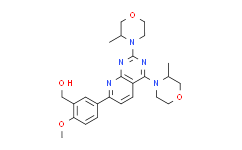| Cas No.: | 1009298-09-2 |
| Chemical Name: | [5-[2,4-Bis((3S)-3-methylmorpholin-4-yl)pyrido[2,3-d]pyrimidin-7-yl]-2-methoxyphenyl]methanol |
| Synonyms: | AZD-8055;(5-(2,4-Bis((S)-3-methylmorpholino)pyrido[2,3-d]pyrimidin-7-yl)-2-methoxyphenyl)methanol;AZD8055;(5-(2,4-Bis((S)-3-methylmorpholino)pyrido-[2,3-d]pyrimidin-7-yl)-2-methoxyphenyl)methanol;[5-[2,4-Bis((3S)-3-methylmorpholin-4-yl)pyrido[2,3-d]pyrimidin-7-yl]-2-methoxyphenyl]methanol;5-[2,4-bis[(3S)-3-methyl-4-morpholinyl]pyrido[2,3-d]pyrimidin-7-yl]-2-methoxyBenzenemethanol;AZD8055 (AZD 8055, AZD-8055,CCG-168);(5-(2,4-bis((3S)-3-methylmorpholin-4-yl)pyrido(2,3-d)pyrimidin-7-yl)-2-methoxyphenyl)methanol;(5-{2,4-bis[(3S)-3-methylmorpholin-4-yl]pyrido[2,3-d]pyrimidin-7-yl}-2-methoxyphenyl)methanol;AZD 8055, AZD8055;CHEMBL1801204;CCG 168;AZD8055,AZD-8055;(5-{2,4-dichloropyrido[2,3-d]pyriMidin-7-yl}-2-Methoxyphenyl)Methyl 2,2-diMethylpropanoate;Propanoic acid, 2,2-dimethyl-, [5-(2,4-dichloropyrido[2,3-d]pyrimidin-7-yl)-2-methoxyphenyl]methyl ester;[5-[2,4-Bis((3S)-3-methylmorpholin-4-yl)pyrido[2,3-d]pyrimidin-7-yl]-2-methoxyphenyl]methanol AZD 8055;AZD 8055;970JJ37FPW;(5-{2,4-bis[(3S)-3-methylmorpholin-4-yl]pyrido[2,3-d] |
| SMILES: | O1C([H])([H])C([H])([H])N(C2C3C([H])=C([H])C(C4C([H])=C([H])C(=C(C([H])([H])O[H])C=4[H])OC([H])([H])[H])=NC=3N=C(N=2)N2C([H])([H])C([H])([H])OC([H])([H])[C@]2([H])C([H])([H])[H])[C@@]([H])(C([H])([H])[H])C1([H])[H] |
| Formula: | C25H31N5O4 |
| M.Wt: | 465.5447 |
| Sotrage: | 2 years -20°C Powder, 2 weeks 4°C in DMSO, 6 months -80°C in DMSO |
| Description: | AZD-8055 is a novel ATP-competitive inhibitor of mTOR kinase with an IC50 of 0.8 nM. AZD-8055 inhibits both mTORC1 and mTORC2. |
| In Vivo: | In mice bearing U87-MG (PTEN null) glioblastoma xenografts, oral treatment with AZD-8055 (AZD8055) results in a dose-dependent tumor growth inhibition of 33%, 48%, and 77% with 2.5, 5, and 10 mg/kg/d twice daily, respectively. A similar dose dependency is observed in nude mice bearing A549 xenografts: tumor growth inhibition is 44%, 55%, and 93% after 2.5, 5, and 10 mg/kg/d twice daily, respectively. AZD8055 also results in significant inhibition of tumor growth and/or regression in breast, lung, colon, prostate, and uterine xenograft models when administered either twice daily at 10 mg/kg or daily at a dose of 20 mg/kg[1]. AZD8055 markedly decreases the phosphorylation levels of mTOR and its substrates and the activation of microglia in vivo, and promotes the microglial polarization from M1 phenotype to M2 phenotype. In addition, administration of AZD8055 following subarachnoid hemorrhage (SAH) significantly ameliorates EBI, including neuronal apoptosis, neuronal necrosis, brain edema and blood-brain barrier permeability[2]. |
| In Vitro: | The inhibitory activity of AZD-8055 (AZD8055) against mTOR is evaluated using two different assays. Using the truncated recombinant mTOR enzyme, the IC50 for AZD8055 is 0.13±0.05 nM. Using native mTOR enzyme complexes extracted from HeLa cells, the IC50 is 0.8±0.2 nM. AZD-8055 shows excellent selectivity (~1,000-fold) against all class I PI3K isoforms and other members of the PI3K-like kinase family. AZD-8055 inhibits the phosphorylation of mTORC1 substrates p70S6K and 4E-BP1 as well as phosphorylation of the mTORC2 substrate AKT and downstream proteins. The cellular IC50s for AZD8055 are calculated as 24±9 nM (n=13) for pAKT Ser473 and 27±3 nM (n=12) for pS6 Ser235/236 in MDA-MB-468 cells[1]. |






















